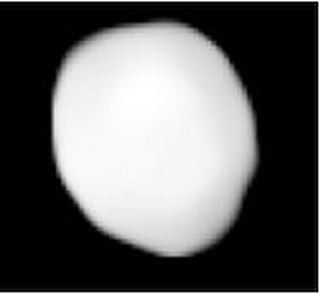
Europa is the 6th-largest asteroid in the asteroid belt, having a diameter of over 300 km, though it is not correspondingly massive. It is not round but is shaped like an ellipsoid of approximately 380×330×250 km. It was discovered on 4 February 1858, by Hermann Goldschmidt from his balcony in Paris. It is named after Europa, one of Zeus's conquests in Greek mythology, a name it shares with Jupiter's moon Europa.
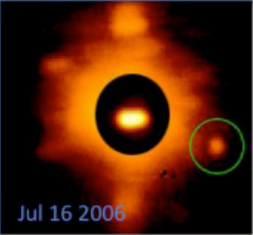
624 Hektor is the largest Jupiter trojan and the namesake of the Hektor family, with a highly elongated shape equivalent in volume to a sphere of approximately 225 to 250 kilometers diameter. It was discovered on 10 February 1907, by astronomer August Kopff at Heidelberg Observatory in southwest Germany, and named after the Trojan prince Hector, from Greek mythology. It has one small 12-kilometer sized satellite, Skamandrios, discovered in 2006.
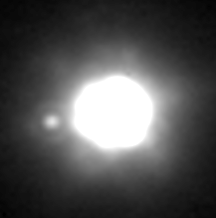
762 Pulcova is a main-belt asteroid. It was discovered by Grigoriy N. Neujmin in 1913, and is named after Pulkovo Observatory, near Saint Petersburg. Pulcova is 137 km in diameter, and is a C-type asteroid, which means that it is dark in colouring with a carbonate composition.

Parthenope is a large, bright main-belt asteroid.
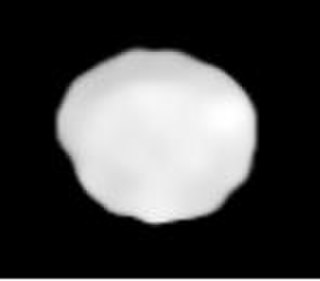
Fortuna is one of the largest main-belt asteroids. It has a composition similar to 1 Ceres: a darkly colored surface that is heavily space-weathered with the composition of primitive organic compounds, including tholins.
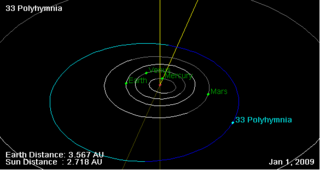
Polyhymnia is a main belt asteroid that was discovered by French astronomer Jean Chacornac on October 28, 1854 and named after Polyhymnia, the Greek Muse of sacred hymns.
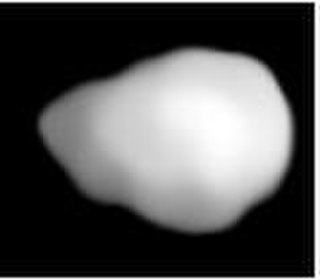
Daphne is a large asteroid from the asteroid belt. It is a dark-surfaced body 174 km in diameter is probably composed of primitive carbonaceous chondrites. The spectra of the asteroid displays evidence of aqueous alteration. It was discovered by H. Goldschmidt on May 22, 1856, and named after Daphne, the nymph in Greek mythology who was turned into a laurel tree. Incorrect orbital calculations initially resulted in 56 Melete being mistaken for a second sighting of Daphne. Daphne was not sighted again until August 31, 1862.

Hestia is a large, dark main-belt asteroid. It is also the primary body of the Hestia clump, a group of asteroids with similar orbits.
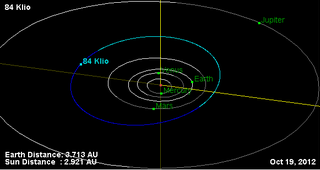
Klio is a fairly large and very dark main-belt asteroid. It was discovered by R. Luther on August 25, 1865, and named after Clio, the Muse of history in Greek mythology. The name Clio had previously been suggested by the discoverer of 12 Victoria, and that is the name B. A. Gould, editor of the prestigious Astronomical Journal, adopted for that asteroid, because of the controversy over the name Victoria. An occultation by Klio over a dim star was observed on April 2, 1997.

Minerva is a large trinary main-belt asteroid. It is a C-type asteroid, meaning that it has a dark surface and possibly a primitive carbonaceous composition. It was discovered by J. C. Watson on 24 August 1867, and named after Minerva, the Roman equivalent of Athena, goddess of wisdom. An occultation of a star by Minerva was observed in France, Spain and the United States on 22 November 1982. An occultation diameter of ~170 km was measured from the observations. Since then two more occultations have been observed, which give an estimated mean diameter of ~150 km for diameter.

Vanadis is a fairly large main-belt asteroid with a diameter of around 100 km. It was discovered by A. Borrelly on August 27, 1884, in Marseilles and was named after Freyja (Vanadis), the Norse fertility goddess. The asteroid is orbiting the Sun at a distance of 2.67 AU with a period of 4.35 yr and an orbital eccentricity of 0.206. The orbital plane is inclined at an angle of 2.10° to the plane of the ecliptic.
Gyptis, minor planet designation: 444 Gyptis, is a main-belt asteroid that was discovered by J. Coggia on March 31, 1899, in Marseilles. It is classified as a C-type asteroid and is probably composed of carbonaceous material. The spectra of the asteroid displays evidence of aqueous alteration.
Peraga is a minor planet orbiting the Sun that was discovered by German astronomer Paul Götz on January 8, 1905, from Heidelberg.
654 Zelinda is a minor planet orbiting the Sun that was discovered on 4 January 1908 by German astronomer August Kopff. On favorable oppositions, it can be as bright as magnitude 10.0, as on January 30, 2016.
118401 LINEAR, provisional designation 1999 RE70, is an asteroid and main-belt comet (176P/LINEAR) that was discovered by the Lincoln Near-Earth Asteroid Research (LINEAR) 1-metre telescopes in Socorro, New Mexico on September 7, 1999. (118401) LINEAR was discovered to be cometary on November 26, 2005, by Henry H. Hsieh and David C. Jewitt as part of the Hawaii Trails project using the Gemini North 8-m telescope on Mauna Kea and was confirmed by the University of Hawaii's 2.2-m (88-in) telescope on December 24–27, 2005, and Gemini on December 29, 2005. Observations using the Spitzer Space Telescope have resulted in an estimate of 4.0±0.4 km for the diameter of (118401) LINEAR.
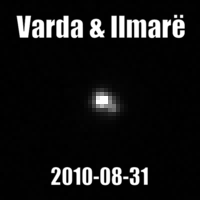
174567 Varda (provisional designation 2003 MW12) is a binary trans-Neptunian planetoid of the resonant hot classical population of the Kuiper belt, located in the outermost region of the Solar System. Its moon, Ilmarë, was discovered in 2009.

2007 TU24 is an Apollo near-Earth asteroid that was discovered by the Catalina Sky Survey in Arizona on 11 October 2007. Imaging radar has estimated that it is 250 meters (820 ft) in diameter. The asteroid passed 554,209 kilometer (344,370 mile or 1.4-lunar distance) from Earth on 29 January 2008 at 08:33 UTC. (At the time of the passage it was believed the closest for any known potentially hazardous asteroid (PHA) of this size before 2027, but in 2010 2005 YU55 was measured to be 400 meters in diameter.) At closest approach the asteroid had an apparent magnitude of 10.3 and was about 50 times fainter than the naked eye can see. It required about a 3-inch (76 mm) telescope to be seen.
13062 Podarkes is a mid-sized Jupiter trojan from the Greek camp, approximately 29 kilometers in diameter. It was discovered on 19 April 1991, by American astronomer couple Carolyn and Eugene Shoemaker at the Palomar Observatory, California. The dark Jovian asteroid is the principal body of the proposed Podarkes family. It was named after Podarkes from Greek mythology.
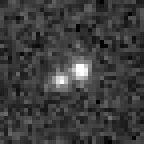
385446 Manwë, or (385446) Manwë–Thorondor, is a binary resonant Kuiper belt object in a 4:7 mean-motion resonance with Neptune. It was discovered on 25 August 2003, by American astronomer Marc Buie at Cerro Tololo Observatory in northern Chile. A study of Manwë's light curve in 2019 suggests that it may be a contact binary object.
2009 BD is a very small asteroid, approximately 10 meters in diameter, which is classified as near-Earth object of the Apollo group and as an Earth co-orbital asteroid.













